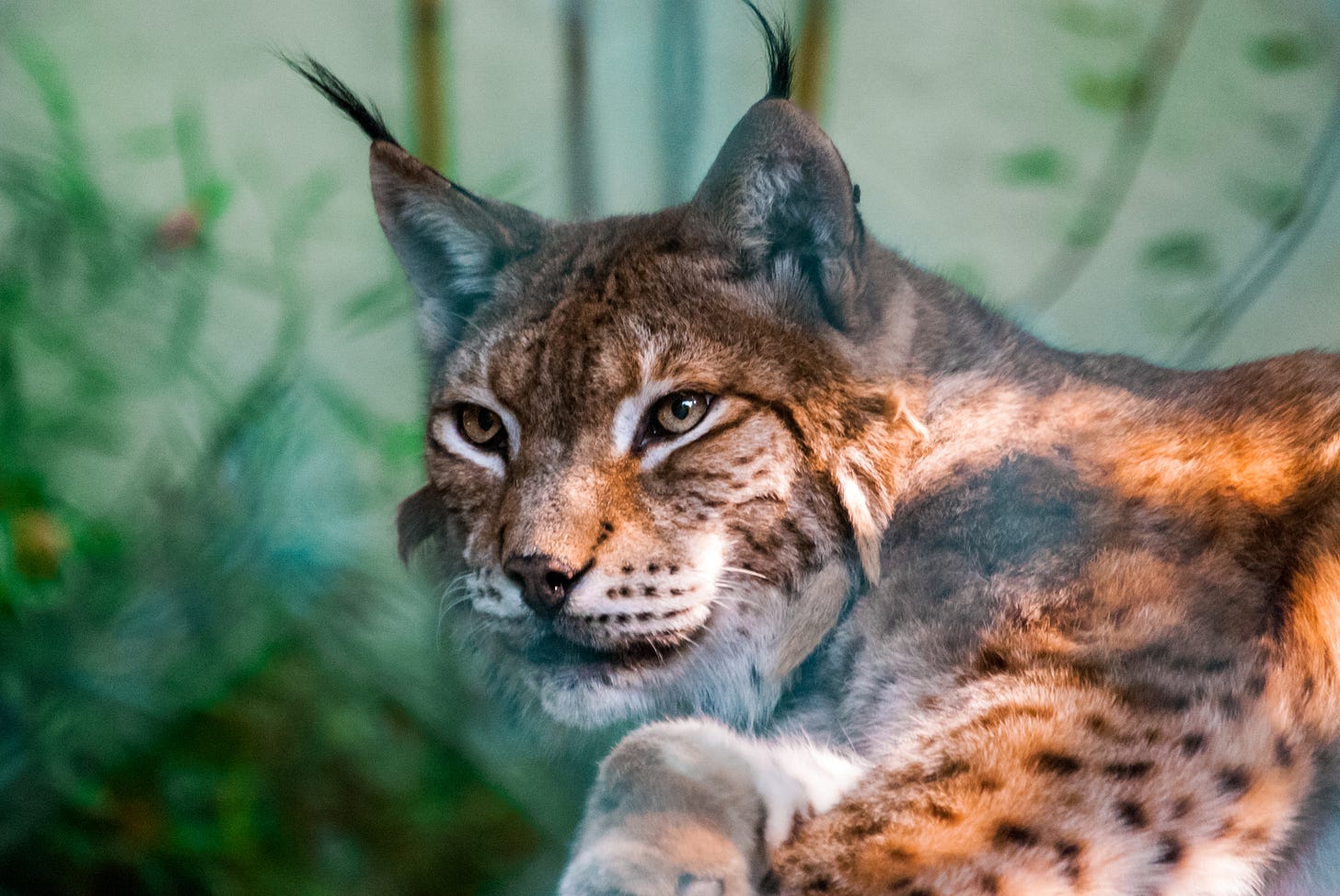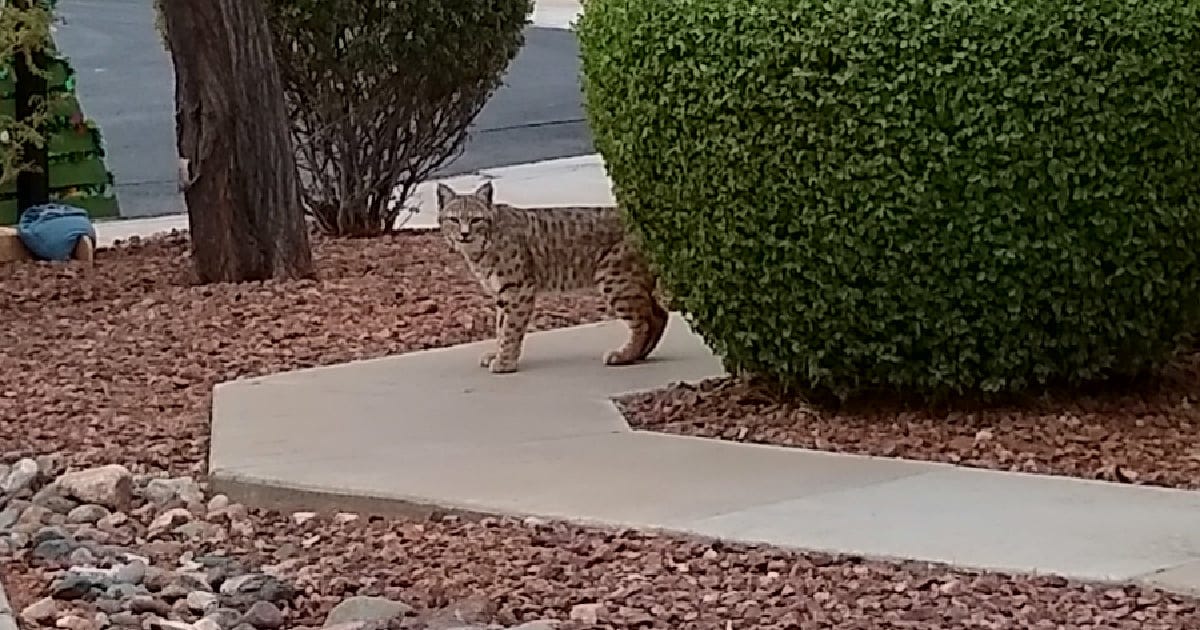Saving the Iberian Lynx in Portugal: A Wildlife Recovery Story
Habitat, Diet, Threats, and Conservation Efforts Behind Portugal’s Endangered Native Cat.

Publishers note:
Join Our Portugal Journey for a special holiday photo project: Christmas in Portugal — and Around the World. Submit one JPG photo of festive lights, nativity scenes, markets, or holiday displays from Portugal or your part of the world. Selected images will appear in a community video shared in December. Learn how to participate and submit your photo by December 8, 2025 here.
Dear Readers,
Not long ago, as Paul and I were driving rural roads along the Portuguese-Spanish border region of the Alentejo in Portugal, we noticed signs along the roadside with images of what looked like (to me) a bobcat, but in fact was an image of an Iberian Lynx. Somewhere in the back of my mind, I remembered something about them being an endangered species. Inspired by those road signs, I decided to learn more about these native cats.
Memories of Arizona wildlife.
When Paul and I lived in Arizona (U.S.), our home was near mountains and open land. We saw a lot of wildlife often right in our backyard. We encountered everything from tarantulas and scorpions to hummingbirds and owls. We also encountered rattlesnakes, coyotes, mountain lions and bobcats.
For the most part (unless the smaller critters got into the house), we didn’t mind sharing the desert, since they had occupied the land long before humans ever did. But as the years went by, and more development, construction, traffic, and suburban sprawl happened, it was the wildlife that suffered (still suffers) the most as much of their habitat is slowly being replaced by humans and “progress”. Unfortunately, I don’t think it’s gotten much better in the 4+ years since we left Arizona.
And as time went on, it was not uncommon for me to watch bobcats from my home office window, effortlessly scaling a 6-foot wall into our backyard to hunt for prey such as rabbits and birds and even small pets. I wonder at what point, these desert creatures will become endangered.

In Portugal, a conservation comeback.
The Iberian lynx (Lynx pardinus) is one of the world’s most endangered feline species and a powerful symbol of wildlife conservation in the Iberian Peninsula. Once on the brink of extinction, this elusive wildcat has been making a slow but steady comeback in Portugal and Spain, where strategic conservation efforts have helped reintroduce and protect the species. In 2002, there were fewer than 100 cats in the wild. In 2024, there were 2,401 Iberian lynxes in the Iberian Peninsula, 1,557 adults or subadults and 844 cubs were born in the wild, according to the 2024 Iberian Lynx Census.
They are solitary, territorial, and mostly active at dawn and dusk. Males can roam up to 40 km, while female roaming territories are smaller.
Where they live in Portugal.
Historically, the Iberian Lynx was found across the Iberian Peninsula, but by the early 2000s, its range had shrunk dramatically. Thanks to reintroduction programs, small populations have now been successfully re-established in these areas:
Guadiana Valley Natural Park (Parque Natural do Vale do Guadiana), in the Mértola region of southern Alentejo.
Sierra de Malcata Natural Reserve in central Portugal, near the Spanish border.
These areas were chosen due to their expansive Mediterranean scrubland, low human population density, and potential for rabbit recovery (their main prey).
How the species declined.
The decline of the species has primarily been driven by two major factors: the sharp reduction in its main food source, the wild rabbit, due to outbreaks of viral diseases such as myxomatosis and rabbit hemorrhagic disease; and changes in land use, including the abandonment of traditional farming methods and certain harmful hunting practices.
Additionally, the species' natural habitat—Mediterranean scrubland and woodland—has been lost or degraded, largely because of the spread of exotic or fast-growing tree plantations (like eucalyptus and maritime pine), the construction of major infrastructure projects (such as roads and dams), and frequent forest fires.
Other serious threats include unnatural deaths (from vehicle collisions and poaching), diseases like bovine tuberculosis, and disturbances in breeding areas, all of which continue to jeopardize the species' survival.
The road signs.

Iberian lynx road warning signs, like the ones Paul and I saw, are found in parts of Alentejo on rural roads linking areas such as Castro Verde to Mértola. These signs mark zones where the endangered lynx frequently traverse. The purpose is to warn drivers of possible lynx crossings, often accompanied by a distance plate (e.g., “1 – 4 km”) indicating the stretch of road drivers should be alert. The signs include the distinctive lynx face - the black silhouette showing ear tufts and facial shape.
How they are protected in Portugal.
Portugal has committed to lynx conservation through:
Captive breeding and reintroduction - A major breeding center in Silves (Algarve) supplies lynx for release into the wild. Lynx are carefully reintroduced with GPS tracking collars.
Habitat protection - Protection of core lynx habitats in Guadiana Valley and surrounding areas and the encouragement of rabbit habitat restoration through landowner agreements and EU funding.
Road safety measures - Lynx crossing road signs and wildlife underpasses, virtual alerts on GPS apps like Waze to notify drivers of lynx crossing areas, and road fencing and tunnels in high-risk areas.
Public awareness and scientific monitoring - Conservation campaigns educate locals on how to report lynx sightings. All lynx are genetically identified and monitored.
While still endangered but now classified as “vulnerable,” the lynx’s return to Portuguese terrain offers hope that with coordinated effort, education, and habitat protection, one of Europe’s rarest predators can thrive once again.
Resource links and further reading.
Iberian lynx census: https://lifelynxconnect.eu/censos/
LPN – Liga para a protecção da natureza: https://www.lpn.pt/en/nature-conservation/lynx-program
ICNF – Instituto da Conservação da Natureza e das Florestas: https://www.icnf.pt/imprensa/populacaodelincesibericossupera2400exemplares
Iberian lynx no longer endangered after numbers improve in Spain and Portugal [The Guardian]: https://www.theguardian.com/environment/article/2024/jun/20/iberian-lynx-vulnerable-not-endangered-after-numbers-improve-in-spain-and-portugal-aoe
Guadiana Valley Natural Park:https://natural.pt/protected-areas/parque-natural-vale-guadiana?locale=en
Sierra de Malcata Natural Reserve: https://natural.pt/protected-areas/reserva-natural-serra-malcata?locale=en
Thanks for being on this journey with me!
Thank you for reading Our Portugal Journey. My newsletter is a reader-supported publication. To receive new posts and support my work, consider becoming a free or paid subscriber to help keep this publication independent.
A Special Thank You to A. for becoming a Paid Supporting Subscriber.
I truly appreciate it!
You can also buy me a coffee or a glass of wine, anytime right here.
Until next time…
Obrigada!
Carol.

